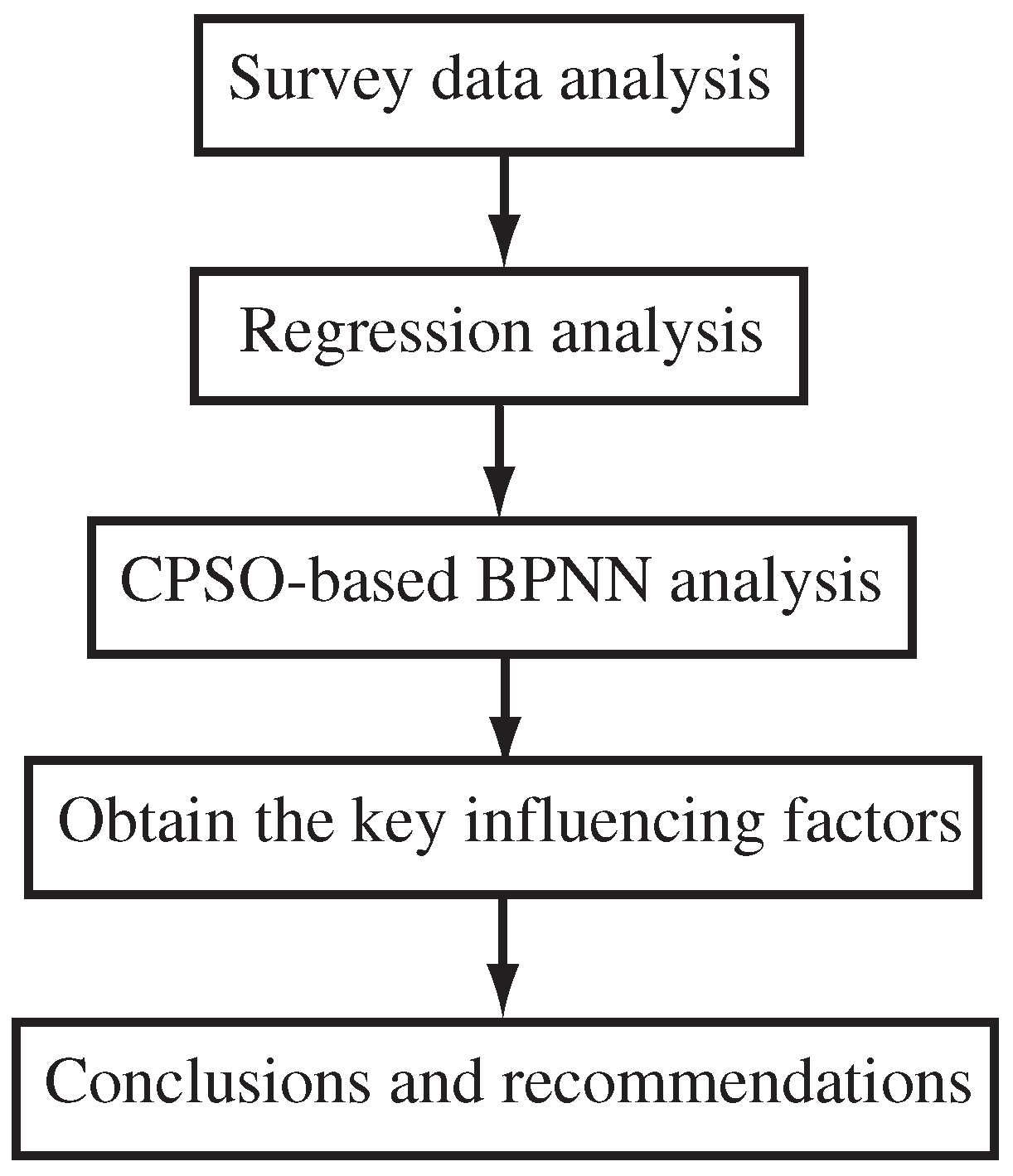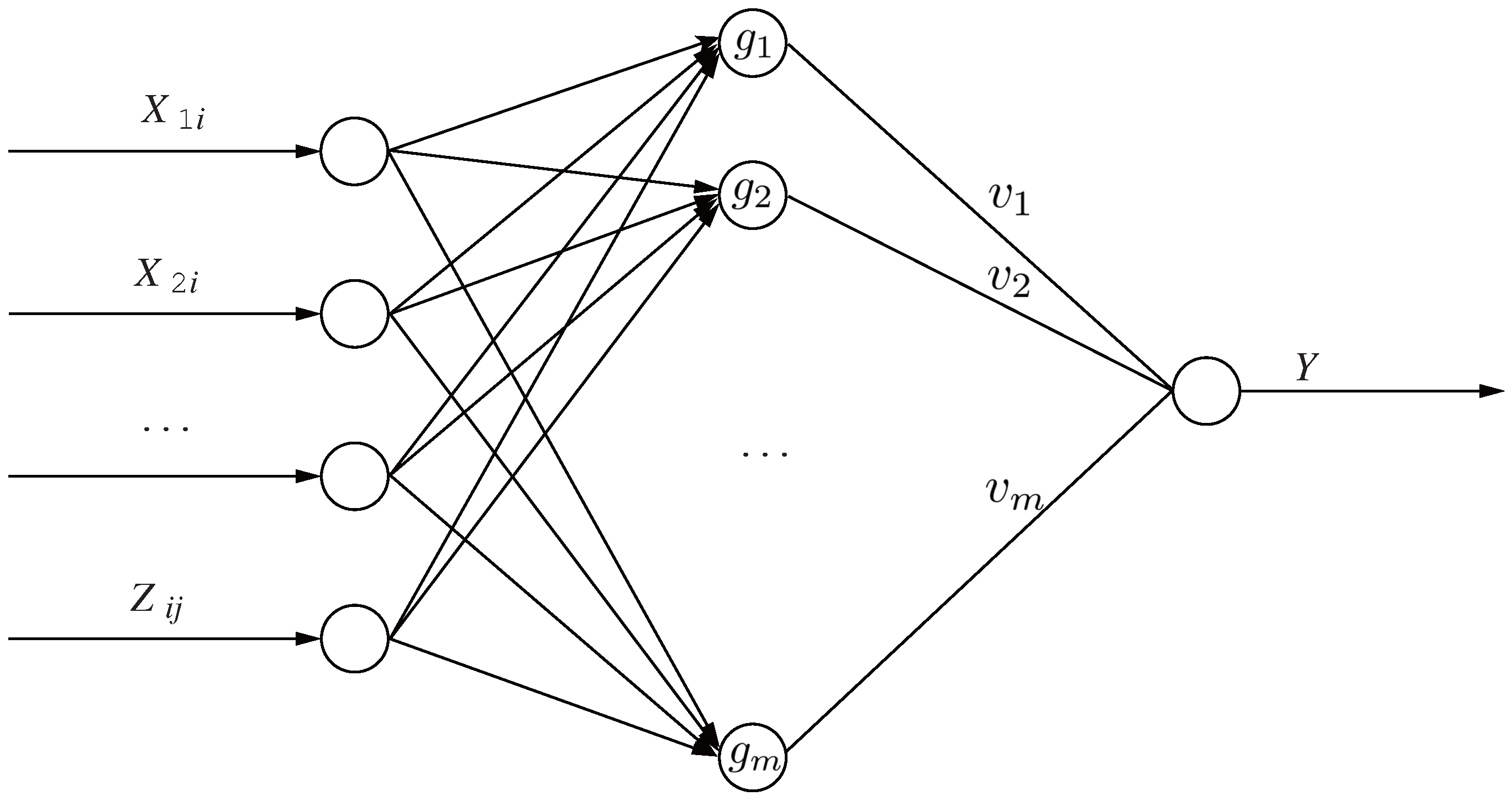A CPSO-BPNN-Based Analysis of Factors Influencing the Mental Health of Urban Youth †
Abstract
1. Introduction
2. Data and Model Analysis
2.1. Data Source
2.2. Variables and Operationalization
2.3. Model Configuration
3. Analysis and Discussion
3.1. Descriptive Statistical Analysis
3.2. The Impact of Residential Style and Living Environment
4. Conclusions and Recommendations
4.1. Conclusions
4.2. Recommendations
Author Contributions
Funding
Institutional Review Board Statement
Informed Consent Statement
Data Availability Statement
Conflicts of Interest
References
- Farahmand, F.K.; Duffy, S.N.; Tailor, M.A.; DuBois, D.L.; Lyon, A.L.; Grant, K.E.; Zarlinski, J.C.; Masini, O.; Zander, K.J.; Nathanson, A.M. Community-based mental health and behavioral programs for low-income urban youth: A meta-analytic review. Clin. Psychol. Sci. Pract. 2012, 19, 195–215. [Google Scholar] [CrossRef]
- Mueller, M.A.E.; Flouri, E.; Kokosi, T. The role of the physical environment in adolescent mental health. Health Place 2019, 58, 102153. [Google Scholar] [CrossRef] [PubMed]
- Cianconi, P.; Betrò, S.; Janiri, L. The impact of climate change on mental health: A systematic descriptive review. Front. Psychiatry 2020, 11, 490206. [Google Scholar] [CrossRef] [PubMed]
- Murphy, L.E.; Jack, H.E.; Concepcion, T.L.; Collins, P.Y. Integrating urban adolescent mental health into urban sustainability collective action: An application of Shiffman & Smith’s framework for global health prioritization. Front. Psychiatry 2020, 11, 44. [Google Scholar]
- Stoddard, S.A.; Meier-Austic, E.; Epstein-Ngo, Q.; Walton, M.; Carter, P.M.; Heinze, J.E.; Zimmerman, M.A.; Cunningham, R. Substance use and mental health predictors of patterns of non-partner youth violence among high-risk urban youth. Drug Alcohol Depend. 2020, 213, 108117. [Google Scholar] [CrossRef] [PubMed]
- Tsang, Y.T.; Franklin, M.; Sala-Hamrick, K.; Kohlberger, B.; Simon, V.A.; Partridge, T.; Barnett, D. Caregivers as gatekeepers: Professional mental health service use among urban minority adolescents. Am. J. Orthopsychiatry 2020, 90, 328. [Google Scholar] [CrossRef] [PubMed]
- Buttazzoni, A.; Doherty, S.; Minaker, L. How do urban environments affect young people’s mental health? A novel conceptual framework to bridge public health, planning, and neurourbanism. Public Health Rep. 2022, 137, 48–61. [Google Scholar] [CrossRef] [PubMed]
- Borg, B.A.; Rabinak, C.A.; Marusak, H.A. Violence exposure and mental health consequences among urban youth. Curr. Psychol. 2023, 42, 8176–8185. [Google Scholar] [CrossRef] [PubMed]
- Xu, J.; Liu, N.; Polemiti, E.; Garcia-Mondragon, L.; Tang, J.; Liu, X.; Lett, T.; Yu, L.; Nöthen, M.M.; Feng, J.; et al. Effects of urban living environments on mental health in adults. Nat. Med. 2023, 29, 1456–1467. [Google Scholar] [CrossRef] [PubMed]
- Collins, P.Y.; Sinha, M.; Concepcion, T.; Patton, G.; Way, T.; McCay, L.; Mensa-Kwao, A.; Herrman, H.; de Leeuw, E.; Anand, N.; et al. Making cities mental health friendly for adolescents and young adults. Nature 2024, 627, 137–148. [Google Scholar] [CrossRef] [PubMed]
- Buttazzoni, A.; Dean, J.; Minaker, L. Urban design and adolescent mental health: A qualitative examination of adolescent emotional responses to pedestrian-and transit-oriented design and cognitive architecture concepts. Health Place 2022, 76, 102825. [Google Scholar] [CrossRef] [PubMed]
- Chaeroni, A.; Kusmaedi, N.; Amung, M.M.; Budiana, D. Physical fitness and mental health in urban and rural areas. Malays. J. Med. Health Sci. 2021, 17, 66–71. [Google Scholar]
- Buttazzoni, A.; Minaker, L. Associations between real-time, self-reported adolescent mental health and urban and architectural design concepts. Cities Health 2024, 8, 318–333. [Google Scholar] [CrossRef]
- Wedyan, M.; Saeidi-Rizi, F. Assessing the impact of urban environments on mental health and perception using deep learning: A review and text mining analysis. J. Urban Health 2024, 101, 327–343. [Google Scholar] [CrossRef] [PubMed]
- Bubalo, M.; van den Broek, K.; Helbich, M.; Labib, S.M. ECO-MIND: Enhancing pro-environmental behaviours and mental health through nature contact for urban youth—A research protocol for a multi-country study using geographic ecological momentary assessment and mental models. BMJ Open 2024, 14, e083578. [Google Scholar] [CrossRef] [PubMed]
- Chhajer, R.; Chaudhry, S.; Mishra, A. Combating the mental health challenge of loneliness among urban youth: Could finding meaning in life and experiencing thriving enhance their well-being? BMC Public Health 2024, 24, 3586. [Google Scholar] [CrossRef] [PubMed]
- Moss, L.; Wu, K.; Tucker, A.; Durbin-Matrone, R.; Roude, G.D.; Francois, S.; Richardson, L.; Theall, K.P. A qualitative exploration of the built environment as a key mechanism of safety and social cohesion for youth in high-violence communities. J. Urban Health 2024, 101, 620–628. [Google Scholar] [CrossRef] [PubMed]
- Shafiei, S.B.; Lone, Z.; Elsayed, A.S.; Hussein, A.A.; Guru, K.A. Identifying mental health status using deep neural network trained by visual metrics. Transl. Psychiatry 2020, 10, 430. [Google Scholar] [CrossRef] [PubMed]
- Du, C.; Liu, C.; Balamurugan, P.; Selvaraj, P. Deep learning-based mental health monitoring scheme for college students using convolutional neural network. Int. J. Artif. Intell. Tools 2021, 30, 2140014. [Google Scholar] [CrossRef]
- Liu, N.; Liu, H.; Liu, H. Mental health diagnosis of college students based on facial recognition and neural network. J. Intell. Fuzzy Syst. 2021, 40, 7061–7072. [Google Scholar] [CrossRef]



| Variable | Mean Value/ Proportion (%) | Variable | Mean Value/ Proportion (%) |
|---|---|---|---|
| Mental Health Level (Average) | 66 | Controlled Variables | |
| Explanatory Variables | Average Age | 27.5 | |
| Residential Style | Sex | ||
| Living Alone | 21.14 | Male | 47.46 |
| Sharing | 44.68 | Female | 52.54 |
| Living With Parents | 32.82 | Marital Status | |
| Other | 1.36 | No Spouse | 73.68 |
| Residential Type | With Spouse | 26.32 | |
| Shared House | 47.28 | Years Of Education (Average) | 14.1 |
| Self-Owned House | 23.65 | Graduate Degree Or Above | 64.28 |
| Long-Term Rental Apartment | 17.60 | Bachelor Degree Or Below | 35.72 |
| Affordable House | 6.15 | Liabilities Type | |
| Unit Dormitory | 5.32 | Consumer Loans | 51.28 |
| Residential Space | House Loans | 33.24 | |
| Independent Space | 74.32 | Education Loans | 11.74 |
| Non-Independent Space | 25.68 | Other | 3.74 |
| Community Environment (Average) | 3.50 | Health Behavior | |
| Social Lifestyle | Smoking | 20.36 | |
| Online | 71.88 | Drinking Alcohol | 26.83 |
| Offline | 28.12 | Both | 50.19 |
| Psychological Counseling | None | 2.62 | |
| Self-Regulation | 43.83 | Self-Rated Health | |
| Confiding | 18.12 | Good | 52.83 |
| Professional Counseling | 10.55 | General | 34.67 |
| Ignore Or Avoid | 27.50 | Poor | 12.50 |
| Variable | Coefficient | Variable | Coefficient |
|---|---|---|---|
| Explanatory Variables | Controlled Variables | ||
| Residential Style | Age | −0.015 | |
| Living Alone | 0.195 | Sex (Reference Group: Male) | |
| Sharing | 0.412 | Female | 0.329 |
| Living With Parents | 0.036 | Marital Status (Reference Group: No Spouse) | |
| Other | 0.140 | With Spouse | 0.528 |
| Residential Type | Category (Reference Group: Local) | ||
| Shared House | 0.438 | Foreign | 0.194 |
| Self-Owned House | 1.135 | Education Level | 0.165 |
| Long-Term Rental Apartment | 0.362 | Self-Rated Health (Reference Group: Good) | |
| Affordable House | 0.478 | General | −2.207 |
| Unit Dormitory | 1.021 | Poor | −3.854 |
| Residential Space | Loans (Reference Group: Other) | ||
| Independent Space | 1.320 | House Loans | −3.84 |
| Non-Independent Space | −0.875 | Education Loans | −2.56 |
| Community Environment | 1.530 | Smoking Frequency (Reference Group: None) | |
| Social Lifestyle | Always Smoking | −3.07 | |
| Online | 0.884 | Sometimes Smoking | 0.383 |
| Offline | 0.712 | Drinking Alcohol Frequency (Reference Group: None) | |
| Psychological Counseling | Always Drinking Alcohol | −0.473 | |
| Self-Regulation | 0.233 | Sometimes Drinking Alcohol | −0.296 |
| Confiding | −0.136 | Income Status (Reference Group: Enough) | |
| Professional Counseling | 0.355 | Not Enough | −1.32 |
| Ignore Or Avoid | −0.135 |
Disclaimer/Publisher’s Note: The statements, opinions and data contained in all publications are solely those of the individual author(s) and contributor(s) and not of MDPI and/or the editor(s). MDPI and/or the editor(s) disclaim responsibility for any injury to people or property resulting from any ideas, methods, instructions or products referred to in the content. |
© 2025 by the authors. Licensee MDPI, Basel, Switzerland. This article is an open access article distributed under the terms and conditions of the Creative Commons Attribution (CC BY) license (https://creativecommons.org/licenses/by/4.0/).
Share and Cite
Xiang, H.; Lan, Y.-H. A CPSO-BPNN-Based Analysis of Factors Influencing the Mental Health of Urban Youth. Information 2025, 16, 505. https://doi.org/10.3390/info16060505
Xiang H, Lan Y-H. A CPSO-BPNN-Based Analysis of Factors Influencing the Mental Health of Urban Youth. Information. 2025; 16(6):505. https://doi.org/10.3390/info16060505
Chicago/Turabian StyleXiang, Hu, and Yong-Hong Lan. 2025. "A CPSO-BPNN-Based Analysis of Factors Influencing the Mental Health of Urban Youth" Information 16, no. 6: 505. https://doi.org/10.3390/info16060505
APA StyleXiang, H., & Lan, Y.-H. (2025). A CPSO-BPNN-Based Analysis of Factors Influencing the Mental Health of Urban Youth. Information, 16(6), 505. https://doi.org/10.3390/info16060505






